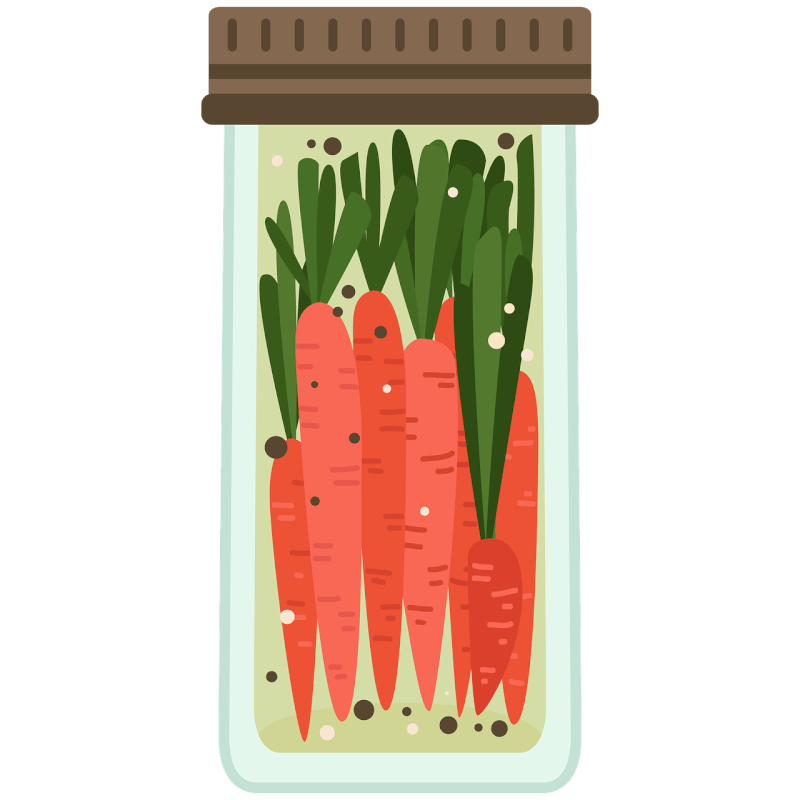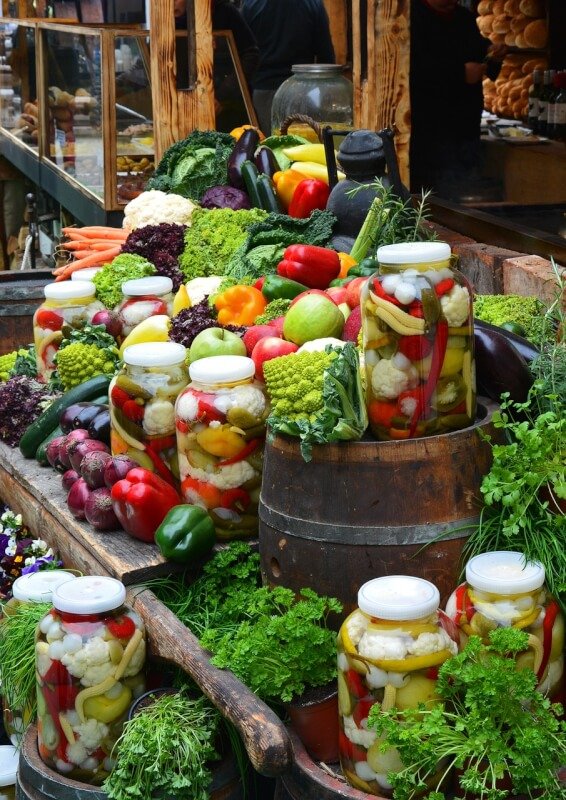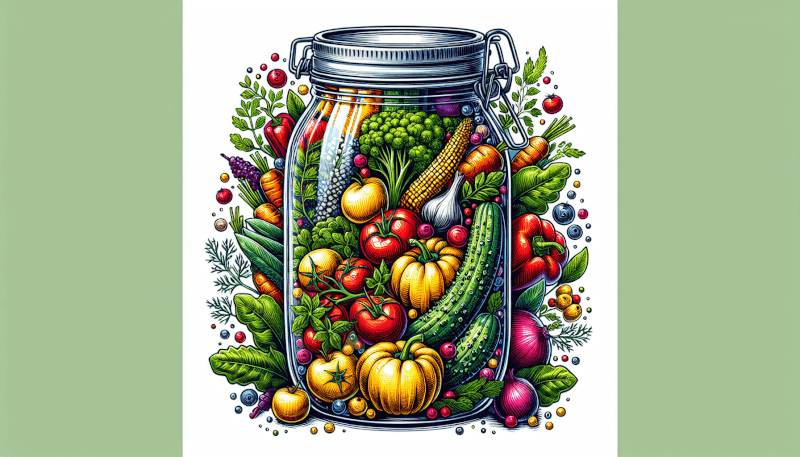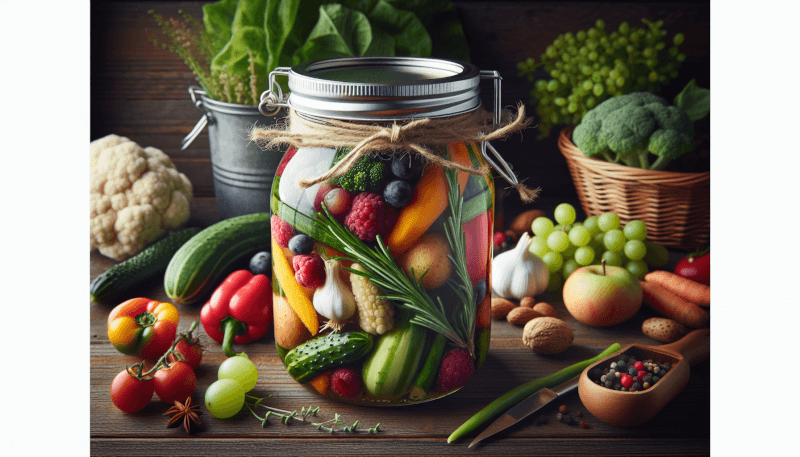Get ready to unlock the delicious potential of your garden harvest with these healthy garden recipes for preserving and fermenting your produce. Whether you have a backyard garden bursting with fresh fruits and vegetables or you frequent your local farmer’s market, this article will guide you on how to make the most out of your bounty. From pickling cucumbers to creating tangy sauerkraut, you’ll discover simple and flavorful recipes that will not only extend the shelf life of your produce but also allow you to enjoy garden-fresh flavors all year round. So grab your apron and let’s get started on this culinary adventure!

How to Preserve Your Garden Produce
Preserving your garden produce is a great way to enjoy the flavors of your harvest year-round. There are several methods you can use to preserve your fruits and vegetables, including canning, freezing, and dehydrating. Each method has its own benefits and can help you prolong the shelf life of your produce. In this article, I will guide you through each of these methods and provide you with some delicious recipes to try.
Canning
Canning is a popular method of preserving fruits, vegetables, sauces, and jams. It involves sealing the food in jars and then heating them to kill any bacteria or microorganisms that could cause spoilage. This process helps to extend the shelf life of the food and allows you to enjoy your garden produce for months to come.
Canning Recipes
Tomato Sauce
Tomato sauce is a versatile base that can be used in various dishes, such as pasta, soups, and stews. To can tomato sauce, start by blanching and peeling the tomatoes. Then, cook them down with onions, garlic, herbs, and spices until you have a thick sauce. Finally, transfer the sauce to sterilized jars and process them in a boiling water bath. The result is a flavorful tomato sauce that will bring a taste of summer to your meals throughout the year.
Peach Jam
Peach jam is a sweet and tangy spread that can be enjoyed on toast, scones, or even as a filling for pastries. To make peach jam, combine peeled and chopped peaches with sugar and lemon juice in a large pot. Allow the mixture to cook down until it reaches a thick, jam-like consistency. Ladle the hot jam into sterilized jars, leaving a ¼ inch headspace, and process them in a boiling water bath. The rich and vibrant flavor of homemade peach jam will surely brighten up your breakfast table.
Pickled Vegetables
Pickled vegetables make a delicious addition to salads, sandwiches, or enjoyed as a tangy snack on their own. To make pickled vegetables, choose a variety of vegetables such as cucumbers, carrots, and cauliflower. Prepare a brine with vinegar, water, salt, and sugar, and bring it to a boil. Pack the vegetables tightly into sterilized jars and pour the hot brine over them. Seal the jars and let them cool before refrigerating. In just a few days, you’ll have crispy and flavorful pickled vegetables ready to be enjoyed.

Freezing
Freezing is another excellent method for preserving your garden produce. It helps to retain the nutritional value and texture of the fruits and vegetables, allowing you to enjoy them throughout the year. Freezing is a simple process that requires minimal preparation and equipment.
Freezing Recipes
Berry Smoothie Packs
Berry smoothie packs are a convenient and healthy way to enjoy the taste of summer fruits all year long. To make berry smoothie packs, start by washing and preparing the berries of your choice. Then, spread them out on a baking sheet and freeze them until solid. Once frozen, transfer the berries to freezer-safe bags or containers. When you’re ready to make a smoothie, simply blend the frozen berries with your favorite liquid and add a sweetener if desired. These frozen berry packs make breakfast prep a breeze!
Roasted Vegetable Medley
Roasting vegetables brings out their natural sweetness and intensifies their flavors. To freeze a roasted vegetable medley, start by chopping a variety of vegetables such as carrots, bell peppers, and zucchini. Toss the vegetables with olive oil, salt, and pepper, and spread them out on a baking sheet. Roast the vegetables in a preheated oven until tender and slightly caramelized. Let them cool completely before transferring them to freezer-safe bags or containers. These roasted veggies can be enjoyed as a side dish or used in soups, stir-fries, or pasta dishes.
Herb Butter
Herb butter is a versatile and flavorful ingredient that can be used to enhance the taste of various dishes. To freeze herb butter, start by softening unsalted butter and mixing in finely chopped fresh herbs such as parsley, rosemary, or thyme. You can also add minced garlic or lemon zest for extra flavor. Shape the herb butter into a log or scoop it into ice cube trays. Wrap the log tightly in plastic wrap or transfer the herb butter cubes into freezer bags. These frozen herb butter portions can be easily added to sauces, sautés, or spread on bread to elevate your culinary creations.
Dehydrating
Dehydrating is a method that involves removing the moisture from food, leaving behind concentrated flavors and a longer shelf life. Dehydrated fruits, vegetables, and herbs make delicious and nutritious snacks that can be enjoyed on their own or incorporated into various recipes.
Dehydrating Recipes
Kale Chips
Kale chips are a fantastic alternative to traditional potato chips, offering a crispy and nutritious snack option. To make kale chips, wash and thoroughly dry kale leaves, removing the tough stems. Toss the leaves with olive oil and seasonings of your choice, such as salt, pepper, or nutritional yeast. Spread the kale leaves out on dehydrator trays and dry them at a low temperature until crispy. Store the kale chips in airtight containers to maintain their crispiness. These homemade kale chips are a guilt-free snack that packs a flavorful punch.
Banana Chips
Banana chips are a sweet and satisfying snack that can be enjoyed on their own or used as a topping for desserts and breakfast bowls. To make banana chips, slice ripe bananas into thin rounds and arrange them on dehydrator trays. You can lightly dust the banana slices with cinnamon or drizzle them with lemon juice to prevent browning. Dehydrate the banana slices at a low temperature until they are dry and crispy. Once fully dehydrated, store the banana chips in airtight containers for a delicious and wholesome treat.
Sun-Dried Tomatoes
Sun-dried tomatoes add a burst of intense flavor to pasta dishes, salads, or sandwiches. To make sun-dried tomatoes, cut ripe tomatoes into halves or quarters and remove the seeds. Season the tomato pieces with salt, pepper, and dried herbs such as basil or oregano. Arrange the tomatoes on dehydrator trays and dry them at a low temperature until they are leathery and slightly chewy. Once dehydrated, store the sun-dried tomatoes in olive oil or use them as a flavorful addition to your favorite recipes.

The Art of Fermentation
Fermentation is an ancient preservation technique that not only extends the shelf life of food but also enhances their flavors and nutritional value. This preservation method involves the breakdown of sugars by microorganisms like bacteria and yeast, producing lactic acid, alcohol, or other beneficial compounds.
Benefits of Fermented Foods
Fermented foods have gained popularity in recent years due to their numerous health benefits. These foods contain probiotics, which are beneficial bacteria that support gut health and aid in digestion. Regular consumption of fermented foods may improve immune function, promote a healthy weight, and even enhance mood and mental well-being. Adding fermented foods to your diet can be a flavorful way to improve your overall health.
Basic Fermentation Process
The basic fermentation process involves creating an environment conducive to the growth of beneficial bacteria and yeast. This is done by submerging vegetables or fruits in a brine solution or mixing them with a culture starter such as whey or salt. The naturally occurring bacteria or yeast on the surface of the produce then consume the sugars and produce various compounds that give fermented foods their distinct flavors.
Equipment and Supplies Needed
To get started with fermentation, there are a few essential items you will need. These include fermentation vessels such as glass jars or crocks, a weight to keep the produce submerged, and an airlock to allow carbon dioxide to escape while preventing the entry of oxygen and contaminants. Fermentation weights can be as simple as clean stones, while airlocks can be purchased online or at specialty kitchen stores. Additionally, you will need a clean workspace, salt or a starter culture, and of course, fresh produce.
Fermented Vegetable Recipes
Fermenting vegetables is a great way to preserve their crunch and introduce tangy and complex flavors to your meals. Here are a few popular fermented vegetable recipes to try:
Sauerkraut
Sauerkraut is a classic fermented cabbage dish that pairs well with sausages, sandwiches, or salads. To make sauerkraut, thinly slice cabbage and mix it with salt. Massage the cabbage to release its natural juices, then pack it tightly into a fermentation vessel, ensuring that the cabbage is submerged in its own liquid. Place a weight on top to keep the cabbage submerged and cover the vessel with an airlock. Let it ferment at room temperature for a few days to several weeks, depending on your desired flavor. The end result is a tangy and probiotic-rich sauerkraut that will add a zesty zing to your dishes.
Kimchi
Kimchi is a spicy and flavorful Korean staple that can be enjoyed as a side dish or used in various recipes. It typically consists of fermented vegetables, such as Napa cabbage, radishes, and scallions, seasoned with a mixture of chili flakes, garlic, ginger, and fish sauce. To make kimchi, chop the vegetables into bite-sized pieces and mix them with the seasoning. Massage the vegetables to evenly distribute the flavors and pack them tightly into jars or fermentation crocks, leaving some headspace. Allow the kimchi to ferment at room temperature for a few days before transferring it to the refrigerator for further aging. The result is a delicious and pungent kimchi that will add a spicy kick to your meals.
Pickled Beets
Pickled beets are a colorful and tangy addition to salads, sandwiches, or enjoyed on their own. To make pickled beets, cook the beets until tender, then peel and slice them into rounds or cubes. Prepare a brine solution with vinegar, water, sugar, and spices of your choice, such as cloves or peppercorns. Bring the brine to a boil and pour it over the beets, ensuring they are fully submerged. Allow the beets to cool and transfer them to a fermentation vessel, making sure they are covered with the brine. Place a weight on top to keep the beets submerged and allow them to ferment at room temperature for a few days. The pickled beets will develop a tangy flavor and can be stored in the refrigerator for several months.

Fermented Fruit Recipes
Fermenting fruits adds complexity and depth to their natural sweetness. Here are a few fermented fruit recipes to try:
Fermented Applesauce
Fermented applesauce is a tangy and refreshing twist on the classic favorite. To make fermented applesauce, peel, core, and chop apples into small chunks. Place the apples in a fermentation vessel and add a starter culture or whey. Mix the apples and culture together until they are well combined. Place a weight on top to keep the apples submerged in their own juices and cover the vessel with an airlock. Allow the apples to ferment at room temperature for a few days, tasting periodically until it reaches your desired level of tanginess. Once fermented, refrigerate the applesauce to slow down the fermentation process. Enjoy the flavorful and probiotic-rich fermented applesauce on its own or as a topping for desserts and breakfast dishes.
Fermented Strawberry Jam
Fermented strawberry jam takes the classic preserve to a whole new level with its tangy and nuanced flavors. To make fermented strawberry jam, combine fresh strawberries with sugar and a culture starter, such as whey or a powdered starter. Mash the strawberries slightly to release their juices and mix them with the sugar and culture. Transfer the mixture to a clean jar and cover it with cheesecloth or a coffee filter secured with a rubber band. Let the mixture ferment at room temperature for a few days, stirring daily. Taste the jam periodically until it reaches your desired level of tartness. Once fermented, refrigerate the jam to halt the fermentation process. Spread the unique and probiotic-rich fermented strawberry jam on toast, pancakes, or use it as a filling for pastries.
Fruit Kvass
Fruit kvass is a traditional Russian fermented beverage that combines the flavors of fruits, water, and a natural sweetener. To make fruit kvass, chop or mash the fruits of your choice, such as berries or apples, and place them in a clean jar. Add water and a sweetener like honey or sugar to the jar, leaving some headspace. Cover the jar with a cloth or a coffee filter secured with a rubber band and let it ferment at room temperature for a few days. The natural yeast present on the fruit will convert the sugars into alcohol, resulting in a slightly fizzy and tangy beverage. Once fermented, strain the fruit kvass and refrigerate it to enjoy a refreshing and probiotic-rich drink.
Fermented Beverage Recipes
In addition to fruit kvass, there are several other fermented beverages that you can easily make at home. Here are a few recipes to try:
Kombucha
Kombucha is a fizzy and tangy tea beverage that has gained immense popularity for its probiotic content and potential health benefits. To make kombucha, start by brewing a batch of sweet tea, using black or green tea, and adding sugar. Once the tea has cooled, transfer it to a fermentation vessel and add a SCOBY (symbiotic culture of bacteria and yeast) along with some starter liquid. Cover the vessel with a cloth or a breathable lid and let it ferment at room temperature for a week to several weeks, depending on your preferences. The result is a tangy and lightly carbonated beverage that can be flavored with fruits, herbs, or spices during a second fermentation. Enjoy the homemade kombucha as a refreshing and gut-friendly drink.
Jun Tea
Jun tea is a fermented beverage similar to kombucha, but instead of black tea, it is made with green tea and honey. To make jun tea, brew a batch of green tea using sweetened water. Once the tea has cooled, transfer it to a fermentation vessel and add a SCOBY along with some starter liquid. Cover the vessel with a cloth or a breathable lid and let it ferment at room temperature for a week to several weeks, similar to kombucha. The result is a naturally effervescent and slightly sweet beverage with a subtle floral flavor. Like kombucha, you can flavor the jun tea during a second fermentation for added variety and depth of taste.
Ginger Beer
Ginger beer is a mildly alcoholic and spicy beverage that can be enjoyed on its own or used as a mixer in cocktails. To make ginger beer, start by grating fresh ginger and placing it in a large pot. Add sugar, water, and spices such as cloves or cinnamon, and bring the mixture to a boil. Simmer the ginger mixture for about 15 minutes, then strain out the ginger solids and let the liquid cool. Once cooled, add a ginger beer plant or ginger bug, which contains beneficial yeast and bacteria, to the liquid. Transfer the mixture to a clean bottle, leaving some headspace, and cover it with a secure lid. Let the ginger beer ferment at room temperature for a few days to a week, depending on your desired level of carbonation. The result is a zingy and slightly carbonated ginger beer that can be enjoyed on its own or mixed into your favorite cocktails.
Combining Preservation Methods
Sometimes, combining different preservation methods can yield even more delicious and versatile results. Here are some examples of how you can combine various preservation methods:
Fermented Pickles
Fermented pickles combine the tanginess of fermentation with the crispness of cucumbers. To make fermented pickles, slice cucumbers into spears or rounds and place them in a fermentation vessel. Add a brine solution made of water, salt, and spices of your choice, such as dill seeds or garlic. Weigh down the cucumbers to keep them submerged in the brine, and cover the vessel with an airlock. Allow the pickles to ferment at room temperature for a few days to several weeks, tasting periodically until they reach your desired level of tanginess. Once fermented, transfer the pickles to the refrigerator to slow down the fermentation process. The resulting pickles will have a crisp texture and a tangy flavor, making them a perfect addition to sandwiches or charcuterie boards.
Freezer Jam
Freezer jam is a quick and easy way to preserve the fresh flavors of fruits without the need for canning equipment. To make freezer jam, mash fresh fruits such as strawberries or raspberries and mix them with sugar and pectin. Let the mixture sit for a few minutes to allow the sugar and pectin to dissolve, then transfer it to sterilized jars or freezer-safe containers. Freeze the jam until solid, and it will retain its fresh taste and vibrant colors. This method allows you to enjoy the taste of summer even during the colder months.
Dried Herb Blends
Creating dried herb blends is a simple way to maximize the flavor of your garden herbs. To make herb blends, harvest your herbs when they are at their peak and carefully remove any dirt or insects. Rinse the herbs thoroughly and pat them dry with a clean towel. Bundle the herbs together and hang them upside down in a warm and well-ventilated area until they are completely dry. Once dry, remove the leaves from the stems and crumble them into a container. Create your own herb blends by combining herbs such as basil, oregano, rosemary, and thyme. These homemade herb blends can be stored in airtight containers and used to enhance the taste of soups, stews, and roasted meats.
Best Practices for Storing Preserved and Fermented Foods
After going through the effort of preserving and fermenting your garden produce, it’s important to store them properly to maintain their quality and flavor. Here are some best practices for storing your preserved and fermented foods:
Labeling and Dating
Properly labeling your preserved and fermented foods is essential for easy identification and organization. Use waterproof labels to clearly indicate the contents and the date of preservation or fermentation. This will help you keep track of the freshness of your foods and ensure you consume them within their recommended storage times.
Proper Storage Containers
Using proper storage containers is key to maintaining the quality of preserved and fermented foods. For canned goods, use glass jars specifically designed for home canning, as they are non-reactive and provide an airtight seal. For frozen foods, opt for freezer-safe bags or containers that are thick and resistant to freezer burn. When fermenting foods, use fermentation vessels made of glass or food-grade plastic that can withstand the acidic environment without leaching harmful chemicals. Proper storage containers will help preserve the flavors and textures of your preserved and fermented foods.
Optimal Storage Conditions
The storage conditions for preserved and fermented foods can vary depending on the specific method used. Canned goods should be stored in a cool, dark place that is free from extreme temperature fluctuations. Frozen foods should be kept at a constant temperature of 0°F (-18°C) or below. Fermented foods can be stored in the refrigerator for short-term consumption or in a cool basement or root cellar for longer-term storage. Ensure that your storage areas are clean, dry, and well-ventilated to prevent spoilage and maintain the quality of your preserved and fermented foods.
By following these best practices, you’ll be able to enjoy the flavors of your garden produce throughout the year. Whether you choose to can, freeze, dehydrate, or ferment your fruits and vegetables, these preservation methods will allow you to savor the taste of summer and reap the health benefits of home-preserved and fermented foods. So get creative, try out the recipes provided, and embark on your journey of preserving and fermenting your garden produce. Happy preserving!


